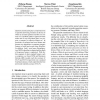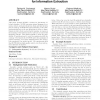122 search results - page 15 / 25 » Sequential Model Selection for Word Sense Disambiguation |
EMNLP
2008
13 years 8 months ago
2008
Question classification plays an important role in question answering. Features are the key to obtain an accurate question classifier. In contrast to Li and Roth (2002)'s app...
ECML
2003
Springer
14 years 18 days ago
2003
Springer
Comparative machine learning experiments have become an important methodology in empirical approaches to natural language processing (i) to investigate which machine learning algor...
COLING
2010
13 years 2 months ago
2010
Word Sense Disambiguation (WSD) often relies on a context model or vector constructed from the words that co-occur with the target word within the same text windows. In most cases...
WWW
2009
ACM
14 years 8 months ago
2009
ACM
This paper presents SOFIE, a system for automated ontology extension. SOFIE can parse natural language documents, extract ontological facts from them and link the facts into an on...
JMLR
2011
13 years 2 months ago
2011
We propose a framework MIC (Multiple Inclusion Criterion) for learning sparse models based on the information theoretic Minimum Description Length (MDL) principle. MIC provides an...


